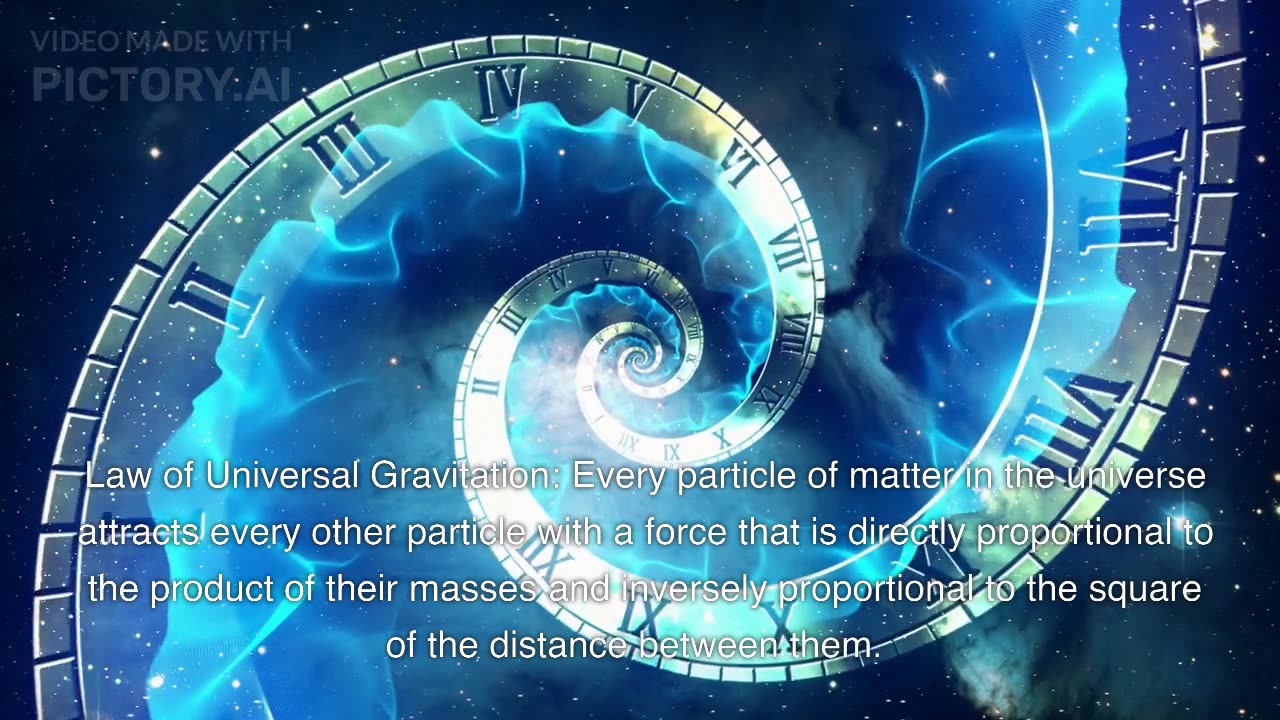Premium Only Content

Basic Physics-Newtons Laws
Newton's laws of gravity refer to three fundamental laws of physics that describe the behavior of gravitational forces between objects. These laws were developed by Sir Isaac Newton in the late 17th century and are still widely used in modern physics and astronomy. The three laws are:
Law of Universal Gravitation: Every particle of matter in the universe attracts every other particle with a force that is directly proportional to the product of their masses and inversely proportional to the square of the distance between them.
Second Law of Motion: The force acting on an object is equal to its mass times its acceleration. This means that the larger the mass of an object, the more force is required to accelerate it.
Third Law of Motion: For every action, there is an equal and opposite reaction. This means that when two objects exert gravitational forces on each other, the force exerted by one object on the other is always equal and opposite to the force exerted by the other object on the first one.
1. Law of Universal Gravitation:
The Law of Universal Gravitation states that every particle of matter in the universe attracts every other particle with a force that is directly proportional to the product of their masses and inversely proportional to the square of the distance between them.
This means that any two objects with mass will exert a gravitational force on each other, and the strength of this force will depend on their masses and the distance between them. The larger the mass of the objects, the stronger the force of gravity between them, and the closer the objects are to each other, the stronger the force of gravity will be.
The equation for the Law of Universal Gravitation is:
F = G * (m1 * m2) / r^2
Where:
F = the force of gravity between the two objects
G = the gravitational constant, a fundamental constant of nature
m1 and m2 = the masses of the two objects
r = the distance between the centers of the two objects
This law explains many phenomena in the universe, from the orbits of planets around the sun to the formation of galaxies. It also helps us understand how objects fall towards the Earth and how satellites stay in orbit around the Earth.
The Second Law of Motion, also known as Newton's Second Law of Motion, states that the force acting on an object is equal to its mass times its acceleration. Mathematically, this is expressed as:
F = m * a
Where:
F = force acting on the object
m = mass of the object
a = acceleration of the object
2. Second Law of Motion:
This law explains how an object will move in response to a force applied to it. If a force is applied to an object, the object will accelerate in the direction of the force. The acceleration of the object will be directly proportional to the force applied and inversely proportional to its mass. This means that the larger the mass of the object, the more force is required to accelerate it.
For example, if you push a book with a certain force, the book will accelerate in the direction of the force. The acceleration of the book will depend on the force you apply and its mass. If you apply a greater force to the book, it will accelerate faster. If the book is heavier, it will require more force to accelerate it to the same degree as a lighter book.
This law is fundamental to understanding many physical phenomena, from the motion of objects in everyday life to the behavior of planets in their orbits around the sun.
3. Third Law of Motion:
The Third Law of Motion, also known as Newton's Third Law of Motion, states that for every action, there is an equal and opposite reaction. This means that if one object exerts a force on a second object, the second object will exert an equal and opposite force on the first object.
Mathematically, this is expressed as:
F₁₂ = -F₂₁
Where:
F₁₂ = the force exerted by object 1 on object 2
F₂₁ = the force exerted by object 2 on object 1
This law can be observed in everyday situations. For example, when you push a box across the floor, the box pushes back with an equal and opposite force. When a rocket engine expels gas out of its back end, the gas exerts a force on the rocket in the opposite direction, propelling it forward.
This law is important in understanding the behavior of many physical systems, from the motion of objects to the interactions between particles at the atomic and subatomic level. It also has practical applications, such as in the design of rockets and other vehicles that rely on the principle of action and reaction to propel themselves.
-
 3:02:07
3:02:07
TimcastIRL
7 hours agoTrump Admin CATCHES Illegal Immigrant POLICE OFFICER, Democrats ARM Illegal In Chicago | Timcast IRL
234K119 -
 4:39:39
4:39:39
SpartakusLIVE
6 hours agoNEW Mode - ZOMBIES || LAST Stream from CREATOR HOUSE
54.9K6 -
 3:36:25
3:36:25
The Charlie Kirk Show
8 hours agoTHOUGHTCRIME Ep. 101 The New York City Communist Debate? MAGA vs Mamdani? Medal of Freedom Reactions
152K62 -
 2:14:47
2:14:47
Flyover Conservatives
1 day agoSatan’s Agenda vs. God’s Timeline: Witchcraft, Israel, and the Assassination of Charlie Kirk w/ Robin D. Bullock and Amanda Grace | FOC Show
56.2K10 -
 3:14:57
3:14:57
PandaSub2000
5 days agoBye Sweet Carole | MIDNIGHT ADVENTURE CLUB (Original Live Version)
40.4K1 -
 1:22:51
1:22:51
Glenn Greenwald
10 hours agoThe Irony of John Bolton's Classified Docs Indictment; Prominent Dems Now Stutter When Asked About AIPAC; Celebs in Saudi Arabia Controversy: What Does it Reveal? | SYSTEM UPDATE #532
102K58 -
 39:25
39:25
Donald Trump Jr.
9 hours agoFBI's Incredible Crime Crackdown, Plus my Message to ABC!! | TRIGGERED Ep.283
156K114 -
 2:53:38
2:53:38
BigTallRedneck
8 hours agoPGA 2K25 - REDNECK'S WAY OR THE HIGHWAY
19.1K1 -
 2:43:58
2:43:58
megimu32
7 hours agoON THE SUBJECT: MTV | From 24/7 Music to… Silence?
13.5K6 -
 4:38:09
4:38:09
Reolock
8 hours agoWoW Classic Hardcore | More Ultra? Maybe Mage?
8.83K